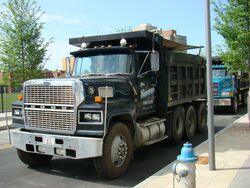 | |
| Manufacturer | Ford Motor Company |
|---|---|
| Production | 1970 - 1998 |
| Successor | Sterling |
| Class | heavy-duty truck |
| Layout | Front engine, rear-wheel drive |
Ford L-Series trucks was a long running series of heavy-duty trucks built by Ford Motor Company between 1970 and 1998. It was distinctively styled with a bold hexagonal grille at its introduction. It was built in a new plant which was called the Kentucky Truck Plant, but its location near Louisville, Kentucky gave rise to the popular name of Ford Louisville line trucks, as well as the "Louisville Plant" [1]
These heavy-duty Ford trucks replaced the short conventional N-Series, along with the heavy-duty F-Series trucks (but not the medium-duty F-Series trucks; which have soldiered on through production, and are still being produced to this day), and related tandem-axle T-Series. The Louisville Line encompassed a wide range of models serving the medium-, heavy-, and extra-heavy-duty truck ranks. The line would become one of the most popular series of trucks Ford ever produced.[1]
Designations
The designation L Series is for the base truck. Designations for variants are listed below:
- LT=Tandem Axle.
- LN=Short Nose (compact hood) Same WB as LS except shorter hood.
- LNT=Short Nose Tandem Axle
- LS=Set Back Front Axle. Shorter WB than L series.
- LTS=Setback Front Axle with Tandem Rear Axles.
- LTL=Tractor-Trailer. Long hood.
- Aeromax=Aerodynamic version of the L-Series.
Styling
Ford L-Series truck styling would influence other Fords. In 1972 the Ford Torino and Ranchero were redesigned with a hexagonal grille that resembled the L-Series. In 1974, the W-Series Cab-Over-Engine trucks would inherit chrome L-Series grilles. The 1978 Ford F-100 pickup would also incorporate a hexagonal themed grille. In 1996, The Louisville Line was redesigned with a sloped windshield and rounded front contours, and had lost the hexagonal front profile.[2] No models with set-back axles would be made after 1996 either. However; production of models with set-back axles eventually resumed after the entire heavy-duty truck division was sold to Freightliner, and the trucks were rebadged as Sterling Trucks.
LTL-9000
In 1976 Ford added the LTL-9000, a truck marketed toward cross-country truck drivers. Two years later, the LTL-9000 would have its own grille and headlight arrangement. The same year Ford introduced the CLT-Cabovers which had identical grilles with the LTL-9000.
Aeromax
In 1988, the basic L-Series truck design was repackaged into the AeroMax. This truck introduced new innovations in class-8 aerodynamics. A setback front axle made possible swept-back front fenders and a smoother form-fitting front bumper. It also had wraparound headlights, tank skirts and an available "Aero Bullet" sleeper unit.[2] The first models were known as the Aeromax 120, and in 1996, they were accompanied by the Aeromax 9500.
The year-span of these newer versions would be short-lived, though. In the late 1990s Ford sold its entire heavy-duty truck division to Freightliner Trucks. The trucks were rebadged as Sterling, a former division of White Motor Company.
Resources
- American Truck & Bus Spotter's Guide: 1920-1985, by Tad Burness.
- Ford Trucks Since 1905, by James K. Wagner.
- Ford Heavy Duty Trucks 1948-1998, by Paul G. McLaughlin.
- Ford Truck Chronicles: by the Auto Editors of Consumers Guide.
References
| This page uses some content from Wikipedia. The original article was at Ford L-Series Trucks. The list of authors can be seen in the page history. As with Tractor & Construction Plant Wiki, the text of Wikipedia is available under the Creative Commons by Attribution License and/or GNU Free Documentation License. Please check page history for when the original article was copied to Wikia |
External links
| ||||||||||||||||||||